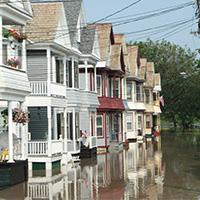Audrey Resutek
MIT Joint Program on the Science and Policy of Global Change
How severely will climate change affect the U.S.? It depends on climate policy, says a new study by MIT researchers.
The National Climate Assessment, released recently by the White House, describes a troubling array of climate woes currently affecting the U.S., from intense droughts and heat waves to more extreme precipitation and floods, all caused by climate change. The report also describes how climate change is expected to impact regions across the U.S. in the future, yet it notes that exact regional forecasts are difficult to pin down. At the larger scale it is clear that climate is changing, but local predictions can disagree on the extent temperatures will increase, and what regions will be hit the hardest with precipitation changes.
In a study published today in Climatic Change, MIT researchers examine the factors that contribute to differing predictions of regional climate change. Often, climate change researchers must try to predict what climate polices will affect emissions in the future, leading to varying estimates of greenhouse gas emissions. The MIT team finds that these differing estimates are the single largest factor contributing to divergent predictions of the severity of climate change by the end of the century.
"It appears that by 2100 the largest source of uncertainty in projections of climate change is also the only source that we have control over—policies that limit emissions,” says Erwan Monier, the lead author of the study and a research scientist at the MIT Joint Program on the Science and Policy of Global Change. “Not knowing the details of a future emissions policy, including the timing or magnitude of reductions, makes it difficult to estimate future emissions—especially in certain regions."
After creating a framework for estimating the range of possible temperature and precipitation changes across different regions of the U.S., the researchers found that some regions were particularly susceptible to wide-ranging predictions. For example, temperature increases in the Pacific Northwest and New England could range from 1°C to 10°C. When climate policy to control greenhouse gas emissions was in place, no region experienced more than 3.5°C warming.
"Our results reflect the need to seriously consider implementing global policy aimed at stabilizing greenhouse gas concentrations in the atmosphere,” Monier says.
In addition to climate policy, other factors affect predictions, including how strongly the climate responds to changes in greenhouse gas concentrations, differences between climate models, and the chaotic nature of the climate system. The study considers how each of these four factors contributes to the uncertainty in predictions of regional climate change in the U.S.
"Regional forecasts are subject to a high level of uncertainty,” Monier says. “We hope that better understanding this uncertainty will lead to more consistent regional predictions."
The research is part of an EPA-lead project, the Climate Change Impacts and Risk Analysis (CIRA) Project, studying the impacts of climate change in the U.S. As part of the project, Monier and colleagues used the same framework to predict possible changes in extreme weather such as heat waves, cold snaps, and severe storms. Their results, supported in part by the NSF Macrosystem Biology Project and published in February in Climatic Change, show that the U.S. can expect more extremely hot days and heavier precipitation.
But the predictions of increasing climate extremes in a business as usual world were not set in stone. Much like in the first study, researchers found that implementing climate policy drastically reduces the expected increase in extreme weather.
Reprint 2014-3
Link to article:



